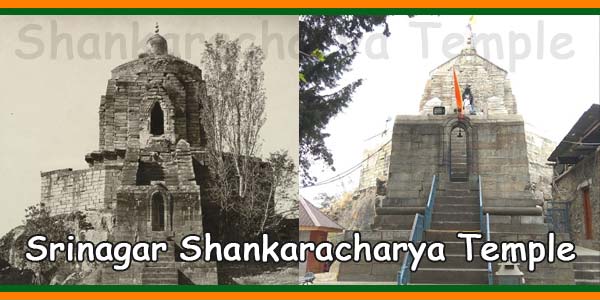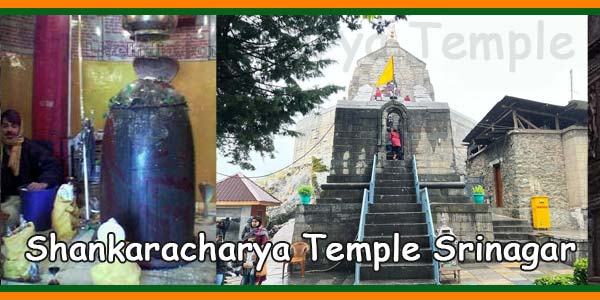
The Sri Shankaracharya Temple, also referred to as the Sri Jyeshteshwara Temple, is a historic Hindu temple located atop the Shankaracharya Hill on the Zabarwan Range in Srinagar, Jammu and Kashmir. This temple is dedicated to God Shiva. The temple is situated at a height of a thousand feet (300 meters) above the valley floor, providing a scenic view overlooking the city of Srinagar. Herath festival (Maha Shivratri), is celebrated by the Kashmiri Hindus.
The temple was built in 371 BC by Raja Gopadatya and was originally called Gopadri. It was later renamed as Shankaracharya Temple after Sri Shankaracharya resided here during his visit to Kashmir. It is believed that Adi Shankaracharya attained spiritual enlightenment at this place and it was after this enlightenment that he went out and formed the four Vedic schools of Advaita, or the philosophy of non-dualism. The Shankaracharya temple sits on a solid rock and is constructed on a high octagonal platform that is approachable by a flight of around 243 steps. Dharmarth Trust has been maintaining the temple since the 19th century.
Shankaracharya Temple Timings: 7:00 AM to 8:00 PM
Note:
The temple is open till 8:00 PM, but the car entry parking area is open till 5:00 PM.
Devotees have to climb 243 steps to reach Shankaracharya Temple, So wear comfortable footwear and carry water.
Shri Amarnath Yatra and Shankaracharya Temple:
Hindu pilgrims, especially those undertaking the sacred Shri Amarnath Yatra, visit the Shankaracharya Temple in significant numbers. The Yatra is one of the most revered Hindu pilgrimages globally. During the new moon’s lunar phase, the sacred mace of Lord Shiva, known as Shiv Bhagwan, is carried to the Srinagar Shankaracharya Mandir. This tradition has been followed for many years as part of the holy Amarnath Yatra.

Shankaracharya Temple History:
The structure is considered the oldest temple in Kashmir, historically and traditionally. It is located on a hill that is a well-preserved Panjal trap formed by volcanic activity of the Permian era. There is no consensus on an exact construction date.
The first historical reference to the hill comes from Kalhana. He called the mountain “Gopadri” or “Gopa Hill”. Kalhana says that King Gopaditya granted the lands at the foot of the hill to the Brahmins who came from “Aryadesa.” The land grant, an Agraharam, was called “Gopa Agraharas.” This area of the base is now called Gupkar. Kalhana mentions another village near the hill where King Gopaditya protected some Brahmins in a neighboring village in present-day Dalgate. Kalhana also mentions that King Gopaditya built the temple on the hilltop as a shrine to Jyesthesvara (Shiva Jyestharuda) around 371 BC.
The Alchon Hun king, Mihirakula, is said to have been the founder of the temple dedicated to Lord Shiva, a shrine called Mihiresvara in Halada, and a large city called Mihirapura.
In 1899, James Fergusson placed the construction of the temple between the 17th and 18th centuries. Fergusson disputes claims that the structures on which he makes this claim came from repairs. Aurel Stein, while acknowledging that the superstructures are of a more recent date, places the base and stairs as much older. Historical figures associated with the monument include Jaloka, one of the sons of Ashoka (Gonandiya), according to Rajatarangini.
Kashmiri Hindus strongly believe that Adi Shankara visited the temple and has been associated with him ever since; hence, the temple and the hill were named Shankaracharya. It was here that the literary work Soundarya Lahari was composed. It was composed by Adi Shankara after he accepted the main faith of the region at that time, the Shakti, and the union of Shiva and Shakti, as in Shaktism, took place in the symbolism of the Sri Yantra.
Names associated with the hill include Sandhimana-Parvata, Koh-e-Suleman, Takht-i-Sulaiman, or simply Takht Hill, Gopadri, or Gopa Hill. Dogra king Gulab Singh (1792-1857 AD) built the steps leading up the hill from the Durga Naag temple side. Earlier, there were also steps leading to Jhelum. Nur Jahan used stepstones during the construction of the Pathar Mosque.
The Maharaja of Mysore came to Kashmir in 1925 and carried out the installation of electric lights in the temple, five around and one at the top. The Maharaja left a donation to finance the cost of electricity. In 1961, Shankaracharya of Dwarkapeetham installed the statue of Adi Shankaracharya in the temple. Sri Aurobindo visited the temple area in 1903. Vinoba Bhave visited it in August 1959.
The Border Roads Organization constructed a 5.6 km road leading to the temple in 1969. Although this was a road construction primarily intended to facilitate the establishment of a communication tower, a portion of the road would be closed to the public. The road would also be used for those traveling to the temple. There are around 240 steps to reach the presiding deity. The Dharmarth Trust has built two small shelters for sadhus here. The hill has a wide range of flora. There is very limited human activity on the hill apart from religious tourism. From the top of the hill, Justine Hardy, a British writer, counted more than 1,350 boats on Dal Lake. Jhelum is visible. The extensive panorama covers important sites like Dal Lake, Jhelum, and Hari Parbat.
Temple Architecture and Design
The temple rests on a solid rock. A 20 ft high octagonal base supports a square building on top. Each side of the octagon measures 15 ft. The front, back, and sides are smooth, while the other four sides have a minimalist design but with visible angles. The center consists of a circle 21.5 ft in diameter with an entrance 3.5 ft wide. The walls are 8 ft high.
The terrace around the square temple is accessed via a stone staircase enclosed between two walls. A door on the opposite side of the stairs leads inside, which is a small, dark room, circular in plan. The roof is supported by four octagonal columns, which surround a basin containing a Lingam surrounded by a snake.
Places near Jyeshteshwara Temple:
Hazratbal Shrine, Pari Mahal, Hari Parbat, Lal Bazar, Anchar Lake, Tulip Garden, Shalimar Bagh, Wular Lake and Dal Lake.
How to reach Shankaracharya Temple
By Air:
Srinagar International Airport is 18.5 km from the Temple. Private Taxis are available from here.
By Rail:
Nowgam Railway Station in Srinagar is located just 22.3 km away from the Temple.
By Road:
Srinagar Bus Stand is 15 km from the Temple. Private Taxis and Autos are available from here.
By Foot:
If you’re in good physical condition, you must trek to the Shankaracharya Temple. The trail commences from the Durga Nag Temple, located in the Civil Lines area of Srinagar. The trek covers a distance of 7 km and involves ascending a significant number of steps to reach the Temple.
Sri Jyeshteshwara Temple Address:
Durgjan,
Srinagar,
Jammu and Kashmir – 190001.
